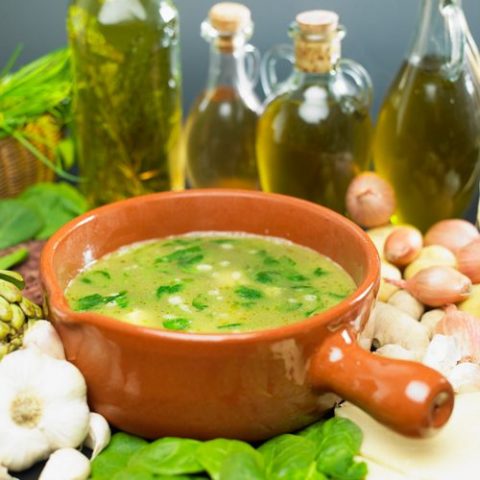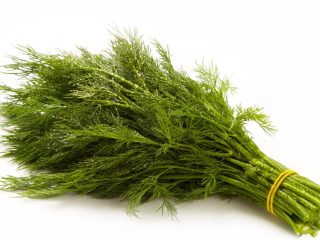Content
For many mothers, feeding their child healthy food is a real problem - not every vegetable will appeal to the kids. It's no secret that spinach is one of these products - not all children like its bland taste. Proven spinach recipes will help your child prepare not only healthy, but also delicious dishes.
What are the benefits of spinach for children?
It’s rare that a housewife has not heard about the benefits of spinach, but despite this, you rarely see dishes made from it on our tables. This leafy vegetable is increasingly present in baby food, since its nutritional value best meets the needs of a growing organism. Vitamins K, E, PP, C, B, A, trace elements zinc, selenium, magnesium, iron, copper, iodine - this is an incomplete list of useful substances contained in this culture. Thanks to its composition, it has a beneficial effect on the entire body:
- normalizes metabolic processes;
- strengthens bones and teeth, is an excellent prevention of rickets;
- increases immunity;
- strengthens blood vessels;
- helps in the treatment of anemia;
- slows down cell aging;
- normalizes digestion;
- helps reduce the risk of cancer;
- strengthens the central nervous system, normalizes metabolic processes in the brain.
In addition, it is well absorbed and does not overload the child’s digestive system. This leafy vegetable is a dietary dish: 100 g of stems and leaves contain only 23 Kcal, and due to the presence of dietary fiber, a feeling of satiety occurs.
At what age can you give your child spinach?
These greens are not allergenic foods, but, like other vegetables, they should be introduced into the diet of an infant gradually, since individual intolerance may occur. The best age to start complementary feeding with spinach is 6-8 months, although in Europe it is included in baby food for 4-6 month olds. You should start by adding a few leaves to your usual food. As with the introduction of any other product, it is important to monitor the child’s individual reaction. Children under one year of age are given spinach up to 2 times a week.
If there are no contraindications, pediatricians recommend introducing dishes from this greenery before the child reaches one year of age - as a rule, older children have difficulty accepting the taste of this product.
How to cook spinach for a baby
Leaves and young stems are added to children's dishes in stewed form. They are carefully sorted, washed and cut into small pieces. Stew in butter in its own juice, sometimes adding water. Spinach can also be boiled, steamed or baked in the oven. Used fresh to prepare salads and thick drinks, and added to sauces.
When preparing spinach dishes, it should be taken into account that heat treatment destroys some of the vitamins, so it is added at the end of cooking. But with deep freezing the vegetable retains all useful substances. Children often use frozen spinach for cooking. To preserve as many nutrients as possible, it is better to add it to dishes without defrosting. It should be borne in mind that during cooking, half as much of this frozen ingredient is added as fresh.
Healthy recipes for children
Spinach can be included as an ingredient in first courses, salads, side dishes, casseroles, and thick drinks. Its taste goes well with meat, poultry, fish, cereals, vegetables, and the composition of vitamins and microelements makes any dish more healthy.
Spinach puree for baby
This basic puree recipe is suitable for very young children who are just getting acquainted with “adult” food. It can be prepared for a baby up to one year old.
Ingredients:
- 500 g spinach leaves;
- 2 tbsp. l. butter;
- some milk.
Preparation:
- Wash and chop the greens.
- Melt the butter in a heavy-bottomed saucepan.
- Add spinach and simmer for 15 minutes in its own juice.
- Cool the resulting mass and grind in a blender.
- Boil the milk.
- Add milk to puree and heat over low heat. Stir the mixture constantly until thickened.
This dish can be varied by adding potatoes, zucchini, carrots, broccoli, cauliflower, pumpkin or other vegetables that are introduced first in complementary feeding. You can add chicken or meat broth to the puree if it is already present in the child’s diet.
Spinach soup for children
For an older child, 2 years old, you can make spinach soup.
Ingredients:
- 1 liter of meat, chicken or vegetable broth;
- 2 medium potatoes;
- about 200 g frozen spinach;
- 1 small carrot;
- salt, spices to taste;
- 1 tbsp. l. lemon juice;
- 1/3 cup boiled rice;
- 1 boiled egg;
- sour cream for dressing.
Preparation:
- Finely chop the potatoes and carrots, place in boiling broth and cook for 20 minutes.
- Add spices, rice, salt and cook for another 2 minutes.
- Add spinach and lemon juice. Simmer over low heat for another 5 minutes.
- Serve with boiled egg and sour cream.
On this basis you can prepare vegetable soup without rice. For an older child, from 3 years old, you can add frying: fry finely chopped onions and grated carrots in vegetable oil before adding to the soup.
Tender soufflé with chicken
In one year, children can be offered spinach as part of a soufflé with chicken. This vegetable helps digest the protein contained in poultry and enriches the dish with vitamins.
Ingredients:
- half a small chicken breast;
- water for boiling chicken;
- 2 tbsp. l. milk;
- 200 g spinach;
- 1 chicken egg;
- 1 tsp. butter;
- salt.
Preparation:
- Boil the chicken fillet in lightly salted water until tender, cool, and chop.
- Wash the spinach and simmer in a saucepan for 5-7 minutes.
- Separate the yolk from the white, add to the chicken, mix the chicken with spinach.
- Beat the egg white and add to the fillet and spinach mixture.
- Transfer the resulting mass into a soufflé mold.
- Bake for 20 minutes in an oven preheated to 180°C.
Green smoothie
If the child does not like the vegetable, the mother will come to the aid of a healthy smoothie recipe that can be prepared in a matter of minutes. It’s not for nothing that smoothies have gained such popularity: they are quick to prepare, healthy, and give you the opportunity to experiment with ingredients to suit your own taste. For example, one year old children can be offered the following green drink:
Ingredients:
- 1 bunch of spinach leaves (can be frozen);
- 200 g water;
- 1 pear;
- 1 tsp. lemon juice;
- 1 tsp. honey (for children over 3 years old).
Preparation:
- Frozen spinach should thaw at room temperature.
- Peel the pear and cut into large pieces.
- Sprinkle with lemon juice.
- Grind pear pieces, spinach, honey in a blender.
- Dilute with water to the desired consistency.
This cocktail is suitable for feeding a child from 11–12 months. If you serve such an emerald drink in a beautiful glass, your child will definitely want to try it. In addition, it is convenient to take it with you on a walk as a snack.
Since spinach goes well with many vegetables and fruits, it can be added to smoothies, for example, with apple, banana, kiwi, lime, cucumber, celery. You can use water, milk, yogurt, kefir as the base of the drink. If your child is not allergic to any of the components of the smoothie, you can safely mix them in the drink. Many mothers prefer to mask the taste of foods that are healthy but not loved by the child, and smoothies are one of the best ways to do this.
You can add crushed oatmeal, previously steamed in boiling water or hot milk, or boiled rice to the cocktail. This will make a great summer breakfast.
Casserole
Casserole is one of the most common children's dishes. There are many variations of this dish.For a child over one and a half years old, you can prepare, for example, a casserole with noodles and spinach.
Ingredients:
- 500 g spinach leaves or shoots;
- 2 chicken eggs;
- 2 tbsp. l. Sahara;
- 1 cup noodles;
- juice of 1 lemon;
- 1 tbsp. l. butter.
Preparation:
- Boil spinach in water for about 3-5 minutes, drain.
- Grind using a meat grinder or blender.
- Beat eggs with sugar.
- Boil the noodles, drain.
- Mix spinach, noodles and egg mixture and add butter.
- Place in a greased pan and bake in an oven preheated to 180–200°C for 15–20 minutes.
This same recipe is easy to make for other spinach casseroles. It is enough to replace the noodles with boiled rice or mashed potatoes, sprinkle the finished dish with finely grated cheese, and a new healthy dish for your child is ready.
Omelette
For a 1-year-old child, you can add spinach to the omelette, and children under 3 years old need to steam it. This breakfast will give you energy for the whole day.
Ingredients:
- 100 g spinach leaves;
- a quarter glass of milk;
- 1 chicken egg;
- 1 tsp. butter;
- a little salt.
Preparation:
- Sauté the washed spinach in oil for 10 minutes.
- Beat the egg with milk, add a little salt.
- Add mixture to sautéed spinach.
- Grease a saucepan with oil, pour the resulting mixture into it;
- Cook for 20 minutes in a steam bath with a lid.
Contraindications and precautions
Although spinach is an extremely healthy product, its composition is not so harmless.When using it in baby food, it should be taken into account that old leaves accumulate oxalic acid, which is harmful to the child’s body, so be sure to choose only young shoots and leaves up to 5 cm long or add dairy products to dishes that neutralize it - milk, butter, cream.
Fresh leaves and shoots are stored in the refrigerator for no more than 2–3 days, since during longer storage they release harmful nitric acid salts.
Children with kidney disease, liver problems, or metabolic disorders should not eat dishes with spinach. If you have any chronic diseases, it would be a good idea to consult a pediatrician.
Conclusion
Spinach recipes for a child will help the mother diversify the menu with tasty and healthy dishes. Among the many options for preparing this vegetable, there are sure to be those that your baby will like, and adding it to familiar dishes will significantly increase their nutritional value. Regular consumption of spinach, subject to simple precautions, will bring exceptional benefits to the body of a growing child.














